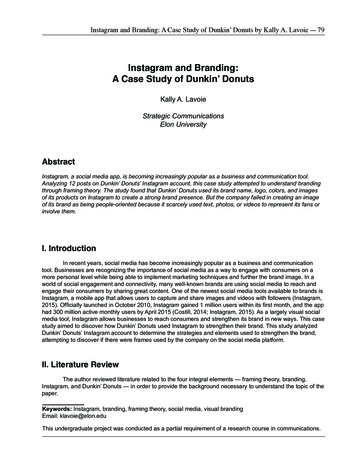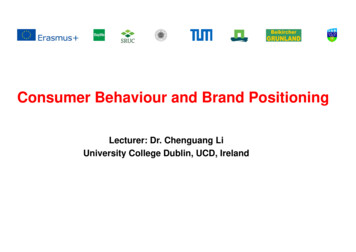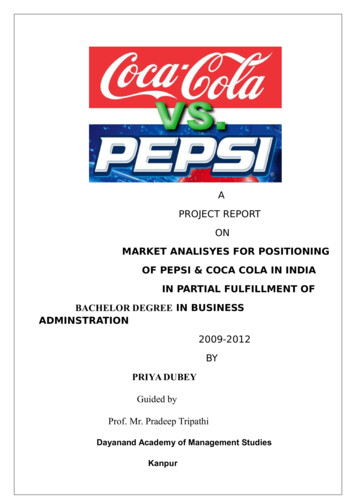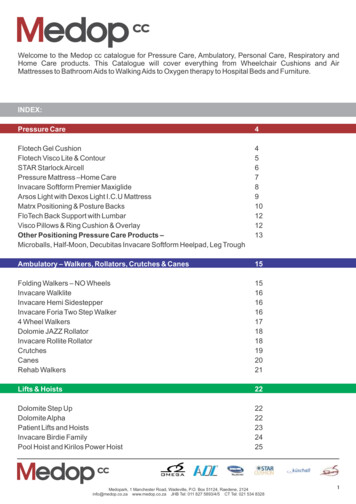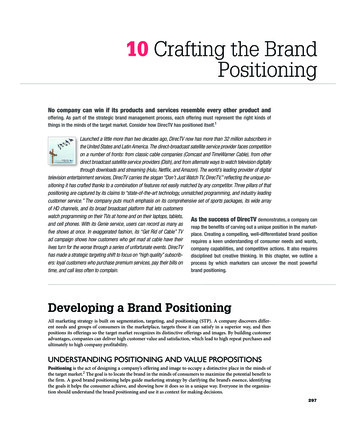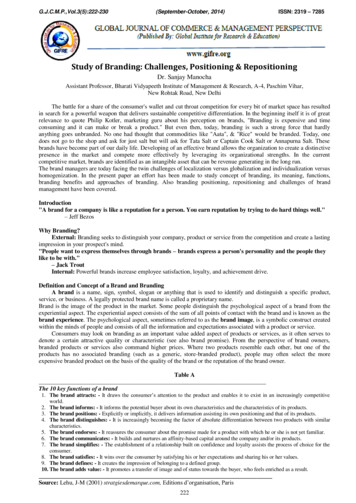
Transcription
G.J.C.M.P.,Vol.3(5):222-230(September-October, 2014)ISSN: 2319 – 7285Study of Branding: Challenges, Positioning & RepositioningDr. Sanjay ManochaAssistant Professor, Bharati Vidyapeeth Institute of Management & Research, A-4, Paschim Vihar,New Rohtak Road, New DelhiThe battle for a share of the consumer's wallet and cut throat competition for every bit of market space has resultedin search for a powerful weapon that delivers sustainable competitive differentiation. In the beginning itself it is of greatrelevance to quote Philip Kotler, marketing guru about his perception on brands, "Branding is expensive and timeconsuming and it can make or break a product." But even then, today, branding is such a strong force that hardlyanything goes unbranded. No one had thought that commodities like "Aata", & "Rice" would be branded. Today, onedoes not go to the shop and ask for just salt but will ask for Tata Salt or Captain Cook Salt or Annapurna Salt. Thesebrands have become part of our daily life. Developing of an effective brand allows the organization to create a distinctivepresence in the market and compete more effectively by leveraging its organizational strengths. In the currentcompetitive market, brands are identified as an intangible asset that can be revenue generating in the long run.The brand managers are today facing the twin challenges of localization versus globalization and individualization versushomogenization. In the present paper an effort has been made to study concept of branding, its meaning, functions,branding benefits and approaches of branding. Also branding positioning, repositioning and challenges of brandmanagement have been covered.Introduction"A brand for a company is like a reputation for a person. You earn reputation by trying to do hard things well."– Jeff BezosWhy Branding?External: Branding seeks to distinguish your company, product or service from the competition and create a lastingimpression in your prospect's mind."People want to express themselves through brands – brands express a person's personality and the people theylike to be with."– Jack TroutInternal: Powerful brands increase employee satisfaction, loyalty, and achievement drive.Definition and Concept of a Brand and BrandingA brand is a name, sign, symbol, slogan or anything that is used to identify and distinguish a specific product,service, or business. A legally protected brand name is called a proprietary name.Brand is the image of the product in the market. Some people distinguish the psychological aspect of a brand from theexperiential aspect. The experiential aspect consists of the sum of all points of contact with the brand and is known as thebrand experience. The psychological aspect, sometimes referred to as the brand image, is a symbolic construct createdwithin the minds of people and consists of all the information and expectations associated with a product or service.Consumers may look on branding as an important value added aspect of products or services, as it often serves todenote a certain attractive quality or characteristic (see also brand promise). From the perspective of brand owners,branded products or services also command higher prices. Where two products resemble each other, but one of theproducts has no associated branding (such as a generic, store-branded product), people may often select the moreexpensive branded product on the basis of the quality of the brand or the reputation of the brand owner.Table AThe 10 key functions of a brand1. The brand attracts: - It draws the consumer’s attention to the product and enables it to exist in an increasingly competitiveworld.2. The brand informs: - It informs the potential buyer about its own characteristics and the characteristics of its products.3. The brand positions: - Explicitly or implicitly, it delivers information assisting its own positioning and that of its products.4. The brand distinguishes: - It is increasingly becoming the factor of absolute differentiation between two products with similarcharacteristics.5. The brand endorses: - It reassures the consumer about the promise made for a product with which he or she is not yet familiar.6. The brand communicates: - It builds and nurtures an affinity-based capital around the company and/or its products.7. The brand simplifies: - The establishment of a relationship built on confidence and loyalty assists the process of choice for theconsumer.8. The brand satisfies: - It wins over the consumer by satisfying his or her expectations and sharing his or her values.9. The brand defines: - It creates the impression of belonging to a defined group.10. The brand adds value: - It promotes a transfer of image and of status towards the buyer, who feels enriched as a result.Source: Lehu, J-M (2001) stratgiesdemarque.com, Editions d’organisation, Paris222
G.J.C.M.P.,Vol.3(5):222-230(September-October, 2014)ISSN: 2319 – 7285Brand AwarenessBrand awareness refers to customers' ability to recall and recognize the brand under different conditions and link tothe brand name, logo, and jingles and so on to certain associations in memory. It helps the customers to understand towhich product or service category the particular brand belongs to and what products and services are sold under the brandname. It also ensures that customers know which of their needs are satisfied by the brand through its products.(Keller)Brand SalienceBrand salience measures the awareness of the brand."To what extent is the brand top-of-mind and easily recalled orrecognized? What types of cues or reminders are necessary?" (Keller)How do customers remember?The tendency of a brand to be thought of in a buying situation is known as “brand salience”. Brand salience is “thepropensity for a brand to be noticed and/or thought of in buying situations” and the higher the brand salience the higherit’s markets penetration and therefore its market share. Salience refers not to what customers think about brands but towhich ones they think about.Brands which come to mind on an unaided basis are likely to be the brands in a customer’s consideration set andthus have a higher probability of being purchased. Advertising weight and brand salience are cues to customersindicating which brands are popular, and customers have a tendency to buy popular brands. Also, an increase in thesalience of one brand can actually inhibit recall of other brands, including brands that otherwise would be candidates forpurchase.It is widely acknowledged that buyer’s do not see their brand as being any different from other brands that areavailable. They buy a particular brand because they are more aware of it, not because it is more distinctive, or has a pointof difference. We now know that all decisions made by humans involve memory processes to a greater or lesser extent.Incoming information from the external environment travels by the sensory memory into the short-term (or working)memory (STM) but if it is not acted upon in a very short time the brain simply discards it.But salient information that is important and received on a regular basis through different channels is passed to thelong-term memory (LTM) where it can be stored for many years. Memories are stored or filed via connections betweennew and existing memories in the different parts of the memory. They are laid down in a framework making somememories easier to access than others. Recall is the process by which an individual reconstructs the stimulus itself frommemory, removed from the physicality’s of that reality.Global BrandA global brand is one which is perceived to reflect the same set of values around the world. Global brands transcendtheir origins and create strong, enduring relationships with consumers across countries and cultures.Global Brands are brands which sold to international markets. Examples of Global Brands include Coca-Cola,McDonald's, Marlboro, Levi's etc. These brands are used to sell the same product across multiple markets, and could beconsidered successful to the extent that the associated products are easily recognizable by the diverse set of consumers.Benefits of Global BrandingIn addition to taking advantage of the outstanding growth opportunities, the following drives the increasing interestin taking brands global: economies of scale (production and distribution) lower marketing costs laying the groundwork for future extensions worldwide maintaining consistent brand imagery quicker identification and integration of innovations (discovered worldwide) preempting international competitors from entering domestic markets or locking you out of other geographic markets increasing international media reach (especially with the explosion of the Internet) is an enabler increases in international business and tourism are also enablersGlobal Brand VariablesThe following elements may differ from country to country: corporate slogan products and services product names product features positioning marketing mixes (including pricing, distribution, media and advertising execution)These differences will depend upon: language differences different styles of communication other cultural differences differences in category and brand development different consumption patterns different competitive sets and marketplace conditions different legal and regulatory environments different national approaches to marketing (media, pricing, distribution, etc.)223
G.J.C.M.P.,Vol.3(5):222-230(September-October, 2014)ISSN: 2319 – 7285Local BrandA brand that is sold and marketed (distributed and promoted) in a relatively small and restricted geographical area.A local brand is a brand that can be found in only one country or region. It may be called a regional brand if the areaencompasses more than one metropolitan market. It may also be a brand that is developed for a specific national market,however an interesting thing about local brand is that the local branding is mostly done by consumers then by theproducers.Brand nameThe brand name is quite often used interchangeably within "brand", although it is more correctly used tospecifically denote written or spoken linguistic elements of any product. In this context a "brand name" constitutes a typeof trademark, if the brand name exclusively identifies the brand owner as the commercial source of products or services.A brand owner may seek to protect proprietary rights in relation to a brand name through trademark registration.Types of brand namesBrand names come in many styles. A few include:Acronym: A name made of initials such as UPS or IBMDescriptive: Names that describe a product benefit or function like Whole Foods or AirbusAlliteration and rhyme: Names that are fun to say and stick in the mind like Reese's Pieces or Dunkin' DonutsEvocative: Names that evoke a relevant vivid image like Amazon or CrestNeologisms: Completely made-up words like KodakForeign word: Adoption of a word from another language like Volvo or SamsungFounders' names: Using the names of real people like Hewlett-Packard or DisneyGeography: Many brands are named for regions and landmarks like Cisco and Fuji FilmPersonification: Many brands take their names from myth like Nike or from the minds of ad execs like Betty CrockerThe act of associating a product or service with a brand has become part of pop culture. Most products have some kind ofbrand identity, from common table salt to designer jeans. A brandnomer is a brand name that has colloquially become ageneric term for a product or service, such as Band-Aid or Kleenex, which are often used to describe any kind ofadhesive bandage or any kind of facial tissue respectively.Brand identityA product identity, or brand image are typically the attributes one associates with a brand, how the brand ownerwants the consumer to perceive the brand - and by extension the branded company, organization, product or service.The brand owner will seek to bridge the gap between the brand image and the brand identity. Effective brand names builda connection between the brand personalities as it is perceived by the target audience and the actual product/service. Thebrand name should be conceptually on target with the product/service (what the company stands for). Furthermore, thebrand name should be on target with the brand demographic. Typically, sustainable brand names are easy to remember,transcend trends and have positive connotations. Brand identity is fundamental to consumer recognition and symbolizesthe brand's differentiation from competitors.Brand identity is what the owner wants to communicate to its potential consumers. However, over time, a productsbrand identity may acquire (evolve), gaining new attributes from consumer perspective but not necessarily from themarketing communications an owner percolates to targeted consumers. Therefore, brand associations become handy tocheck the consumer's perception of the brand.Brand identity needs to focus on authentic qualities - real characteristics of the value and brand promise beingprovided and sustained by organisational and/or production characteristicsVisual Brand IdentityThe visual brand identity manual for Mobil Oil (developed by Chermayeff & Geismar), one of the first visualidentities to integrate logotype, icon, alphabet, color palette, and station architecture to create a comprehensive consumerbrand experience.The recognition and perception of a brand is highly influenced by its visual presentation. A brand’s visual identity isthe overall look of its communications. Effective visual brand identity is achieved by the consistent use of particularvisual elements to create distinction, such as specific fonts, colors, and graphic elements. At the core of every brandidentity is a brand mark, or logo.Branding approachesCompany nameOften, especially in the industrial sector, it is just the company's name which is promoted (leading to one of themost powerful statements of "branding"; the saying, before the company's downgrading, "No on
A global brand is one which is perceived to reflect the same set of values around the world. Global brands transcend their origins and create strong, enduring relationships with consumers across countries and cultures. Global Brands are brands which sold to international markets. Examples of Global Brands include Coca-Cola,

